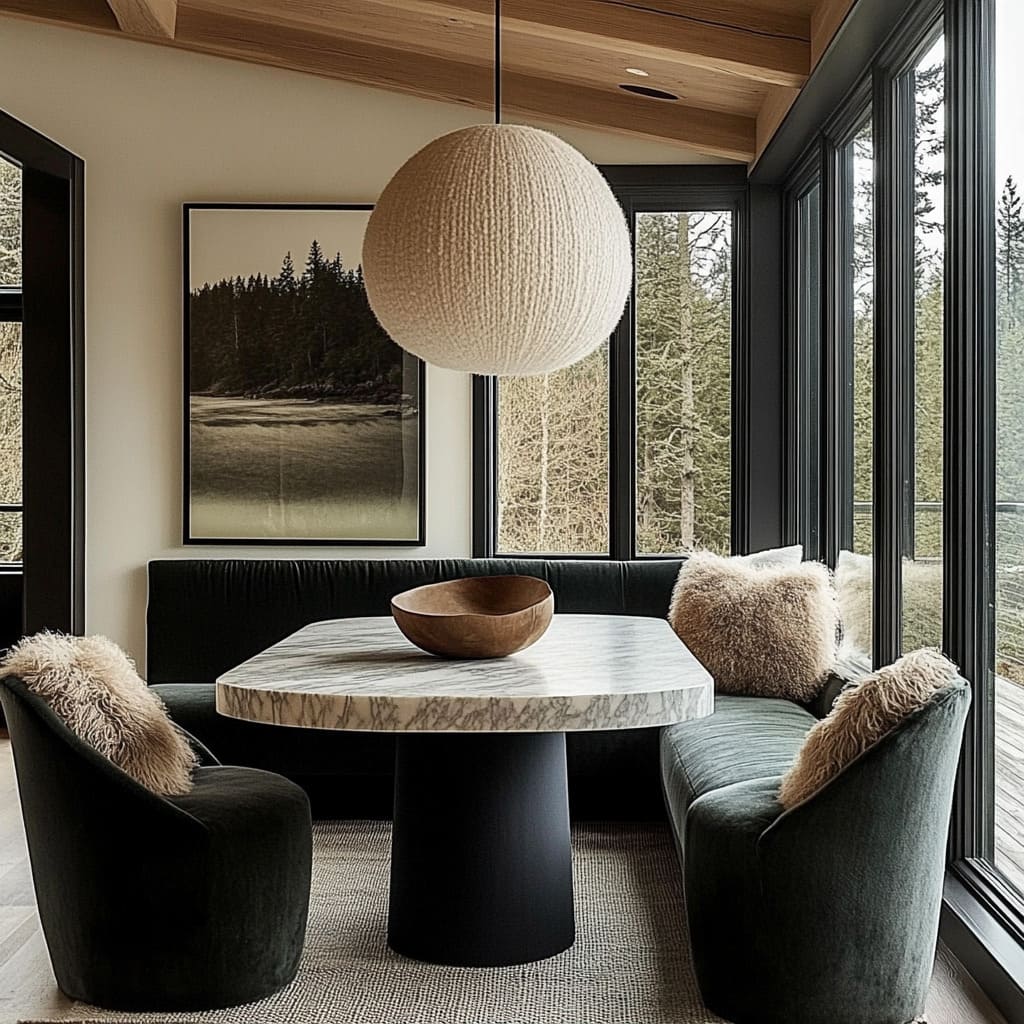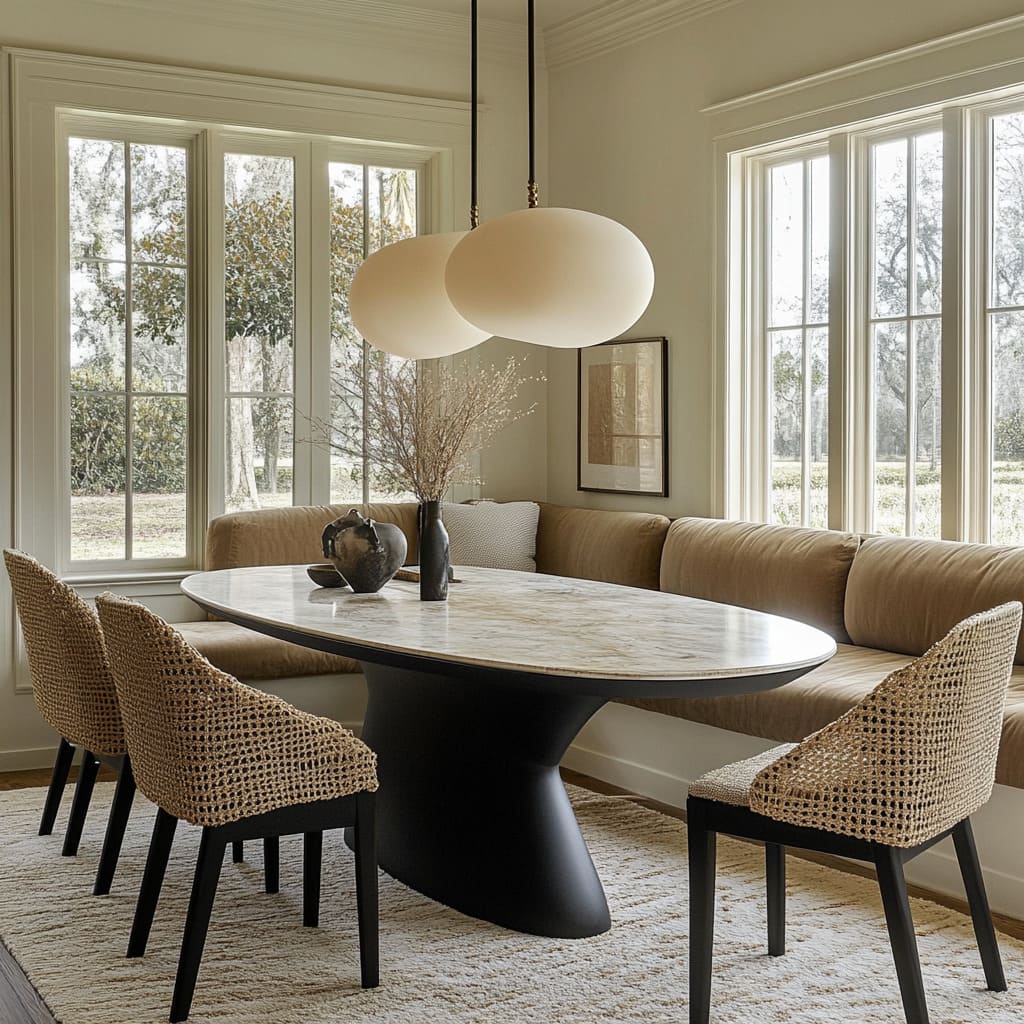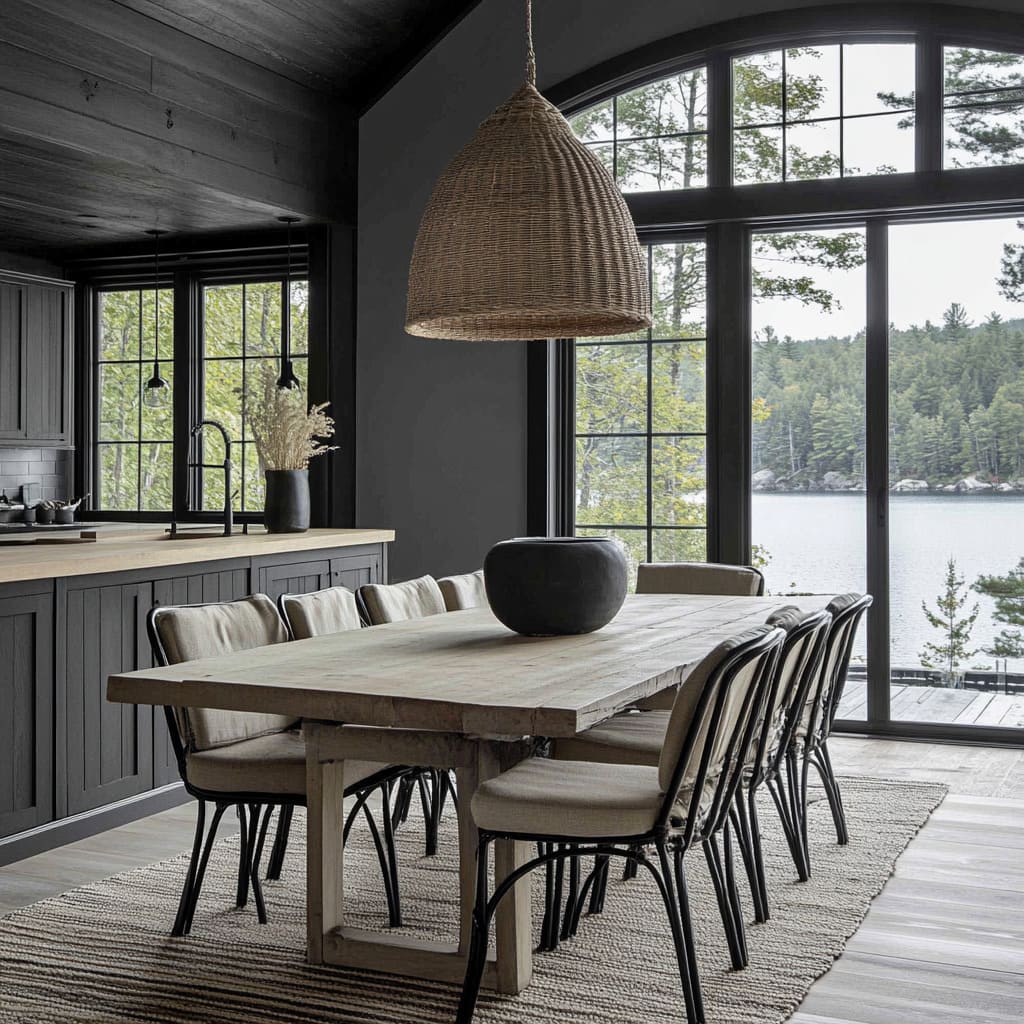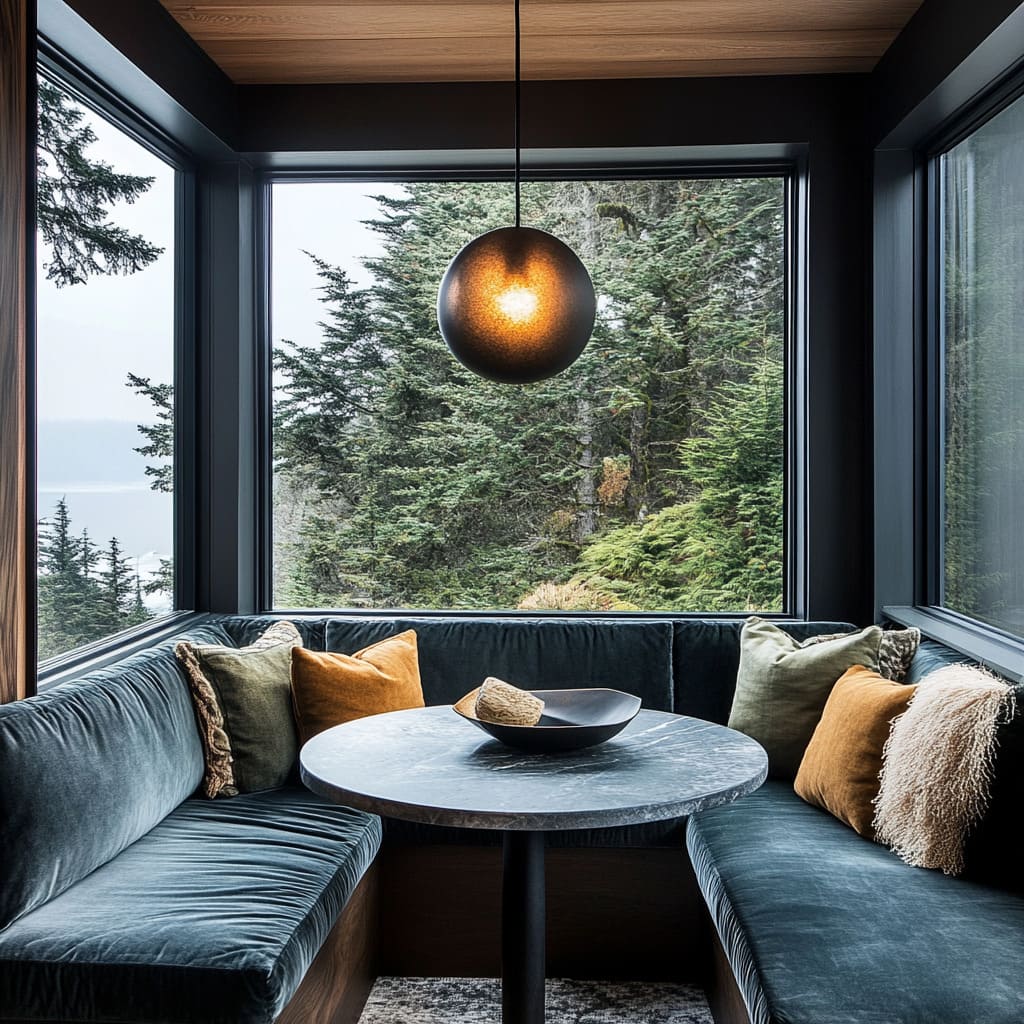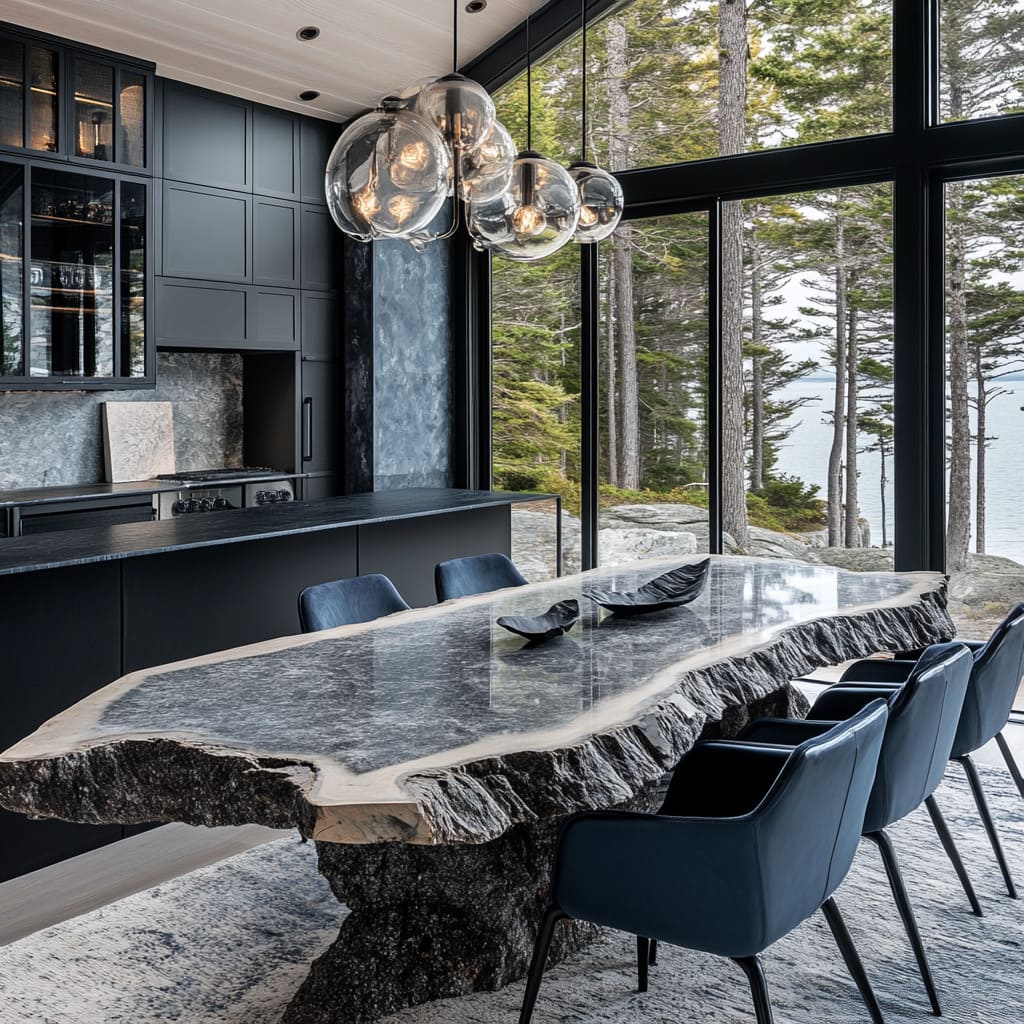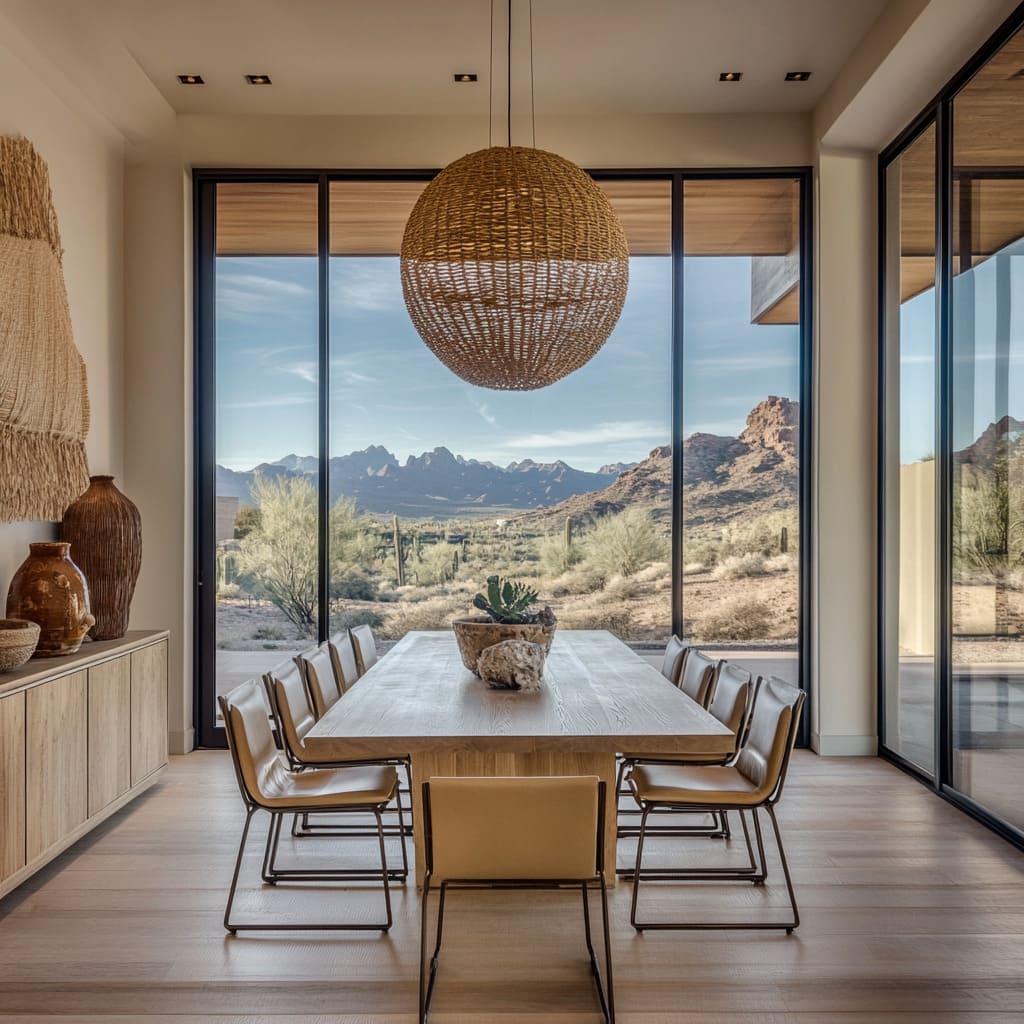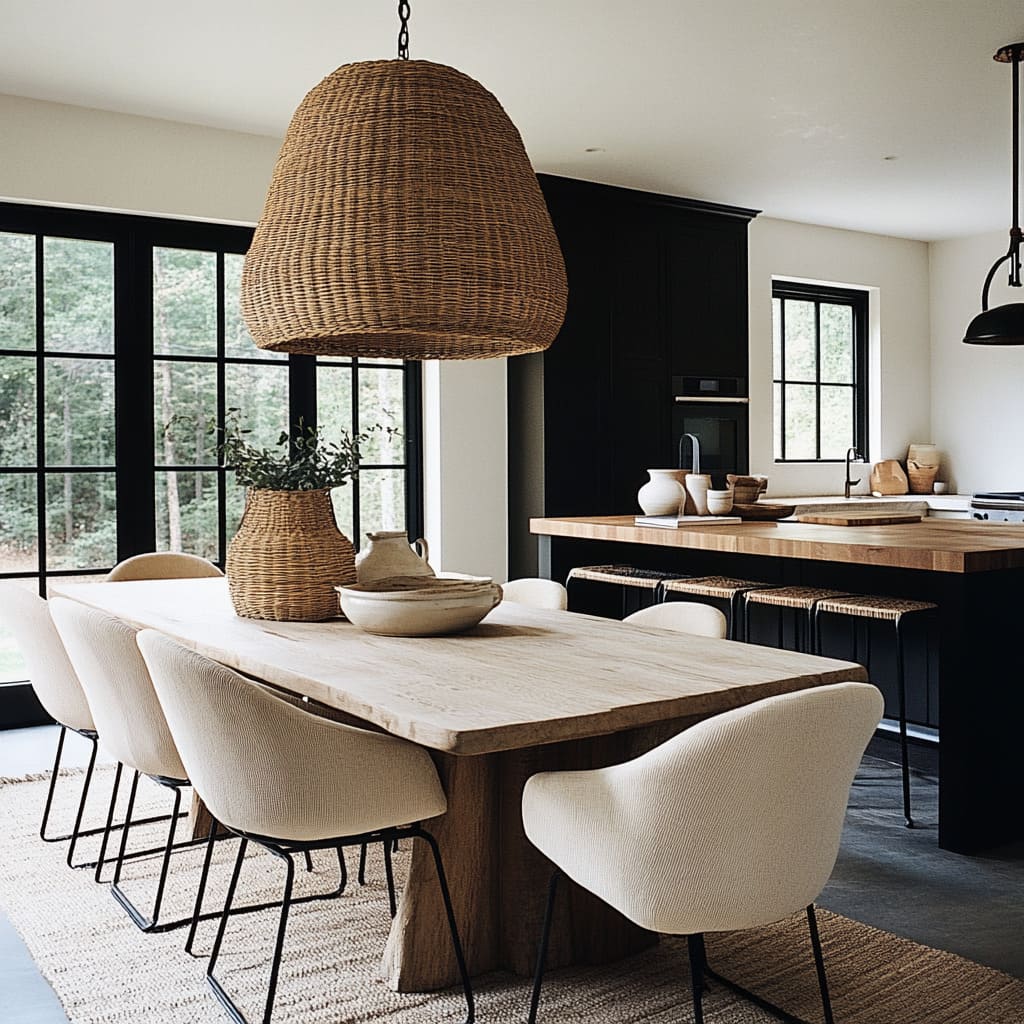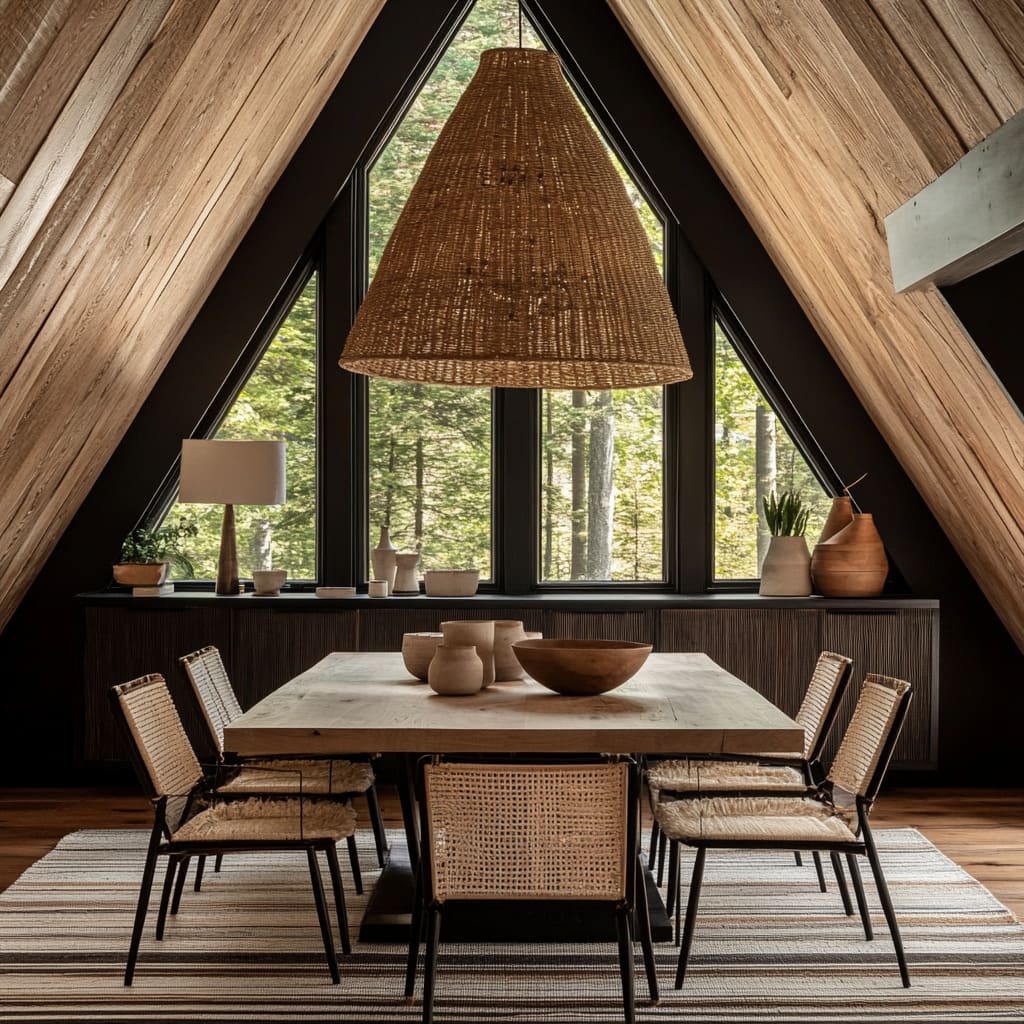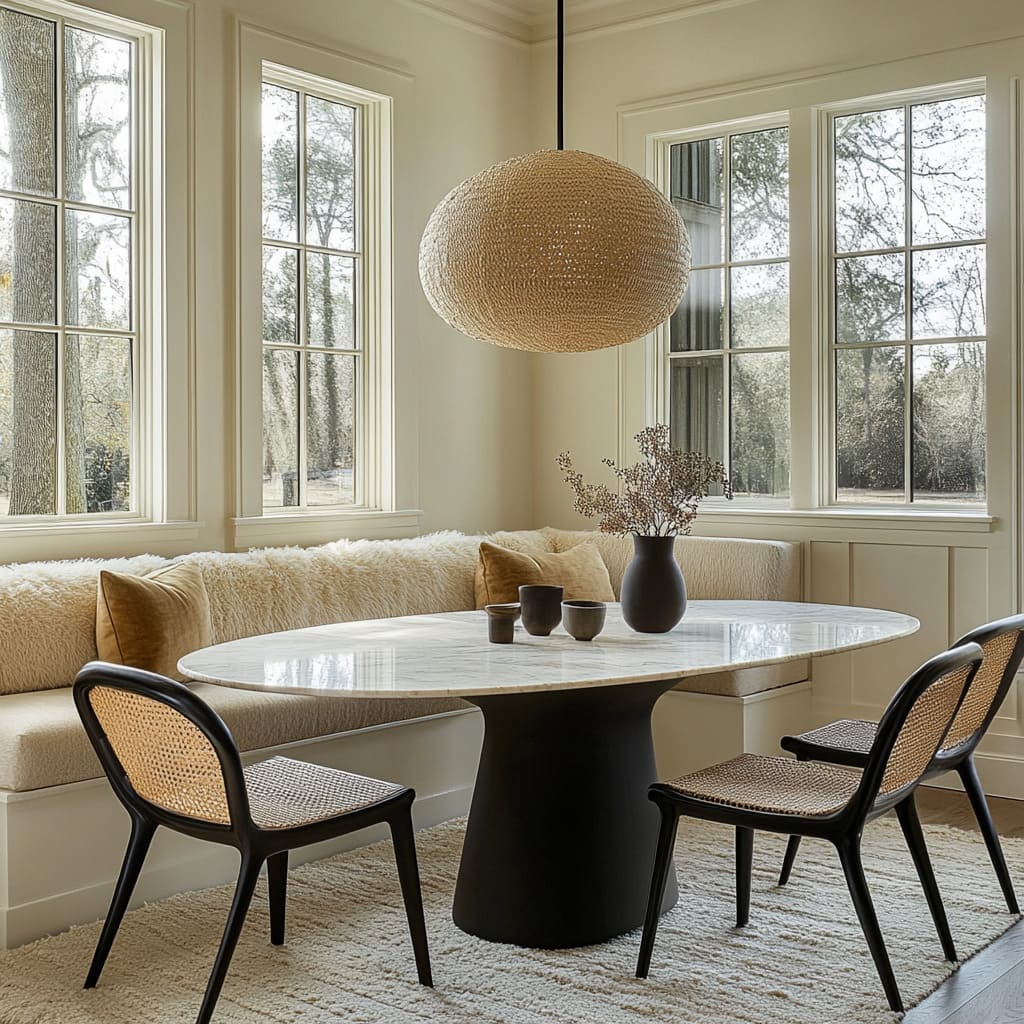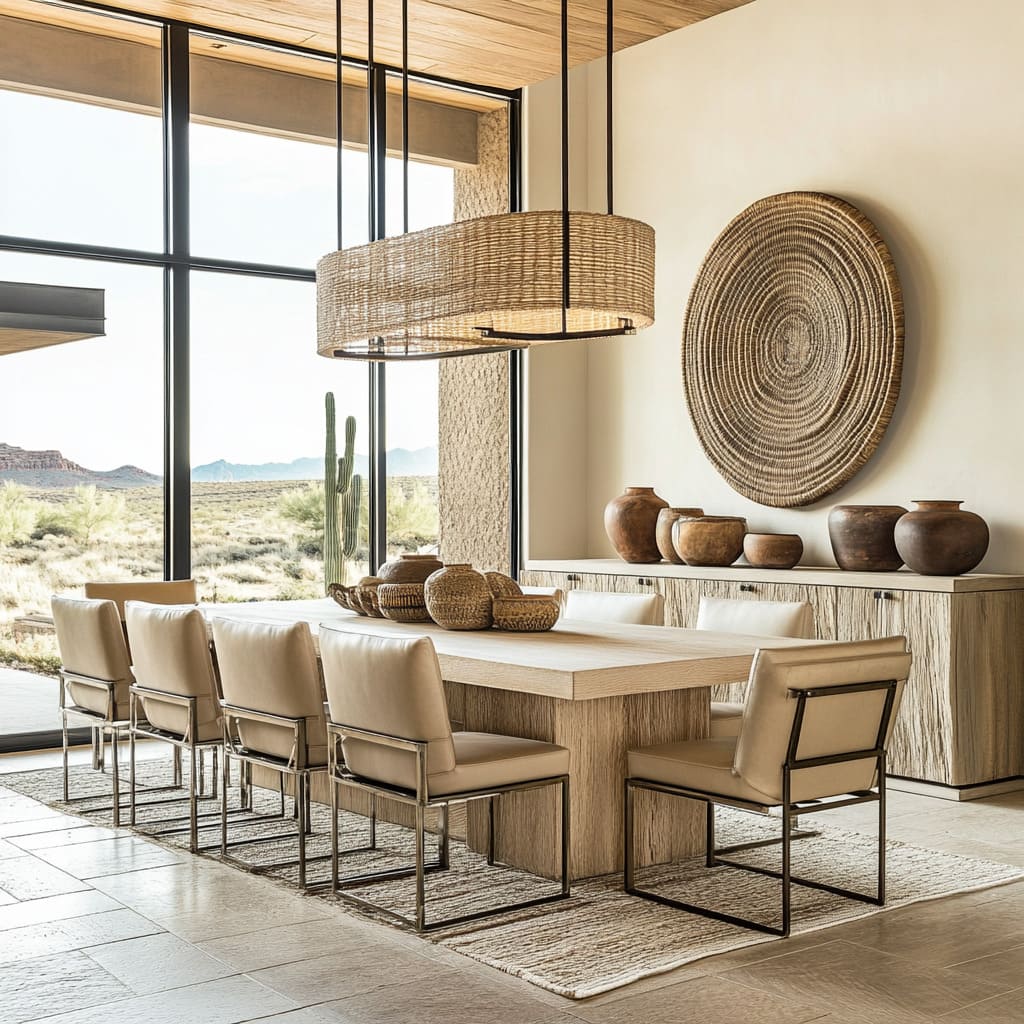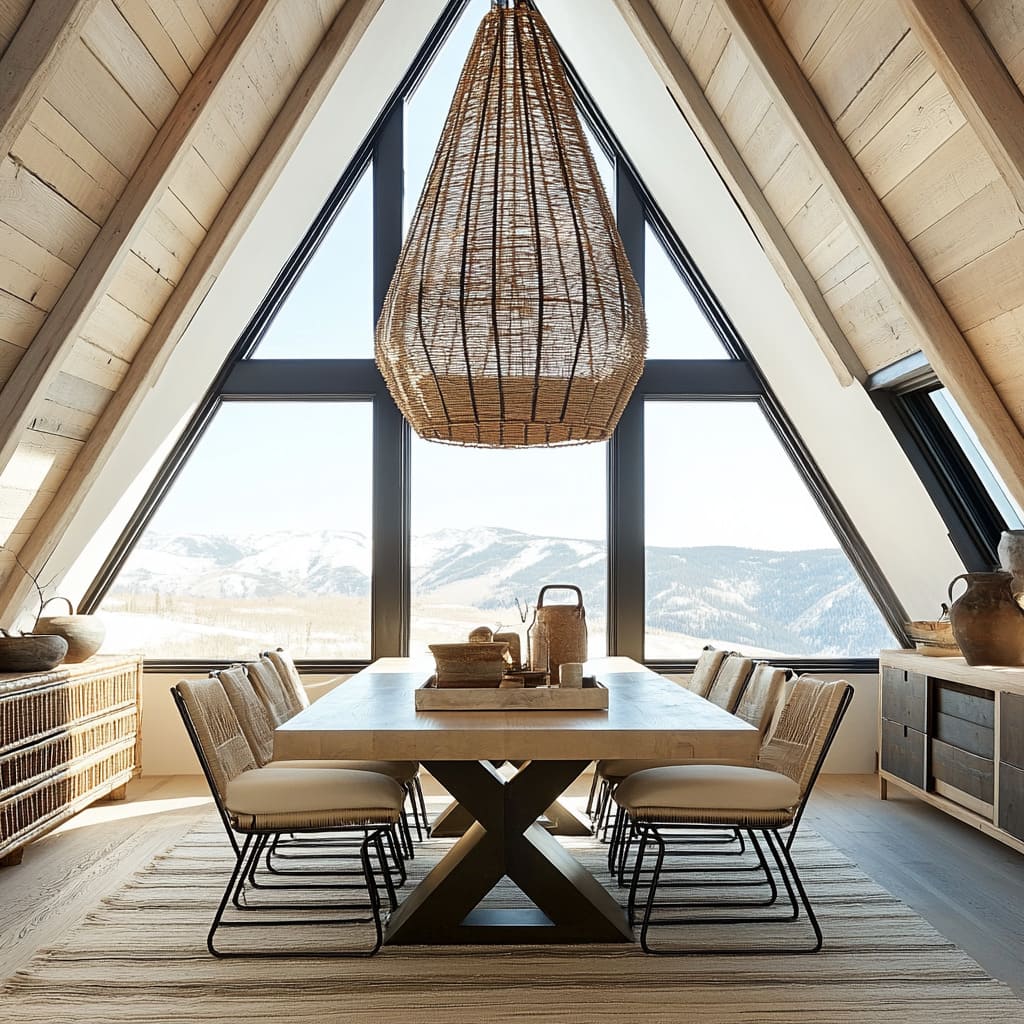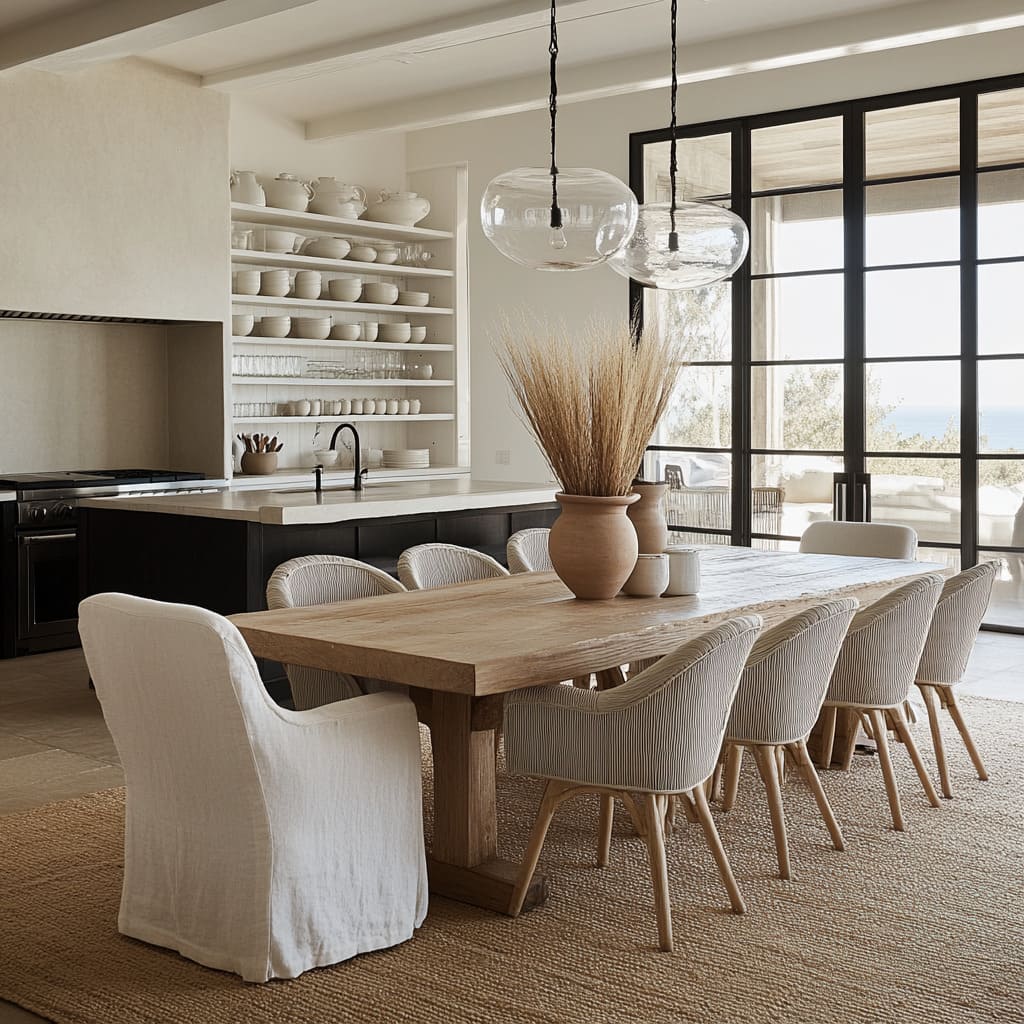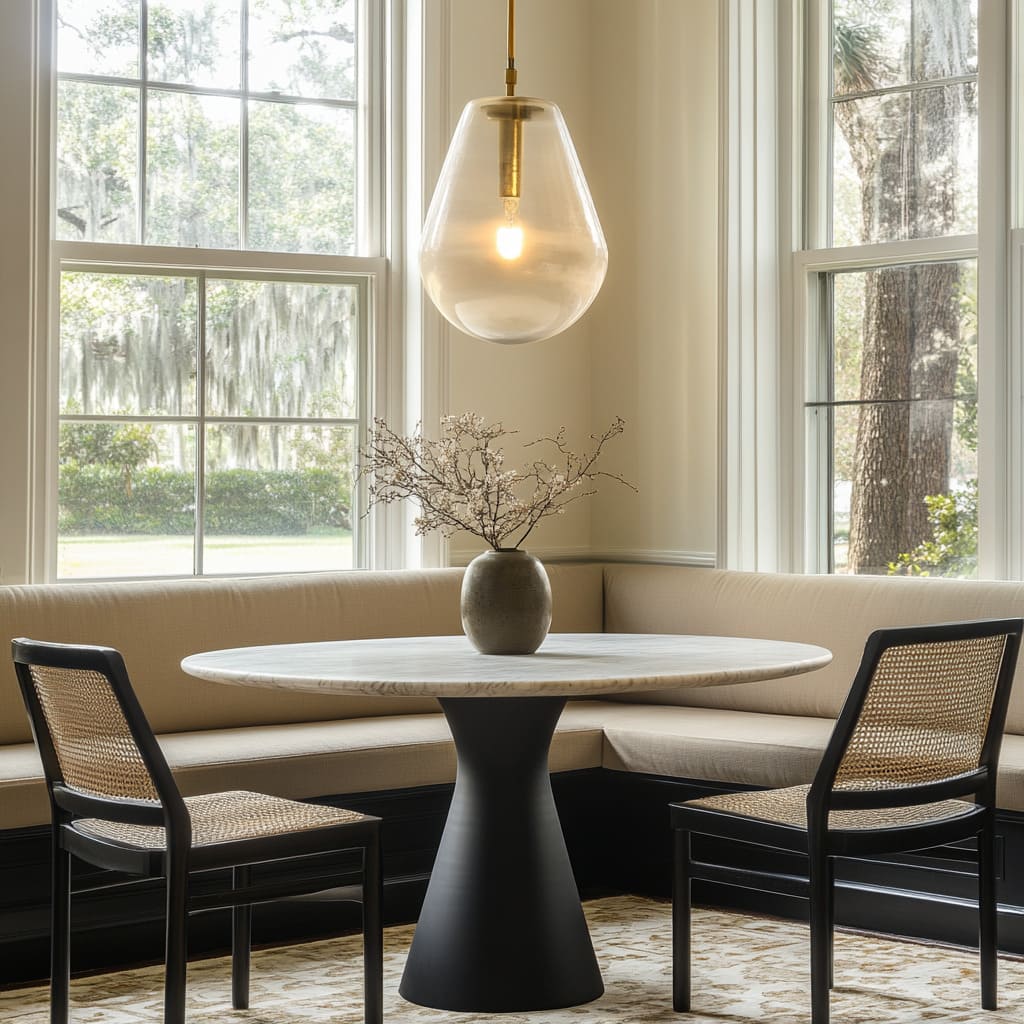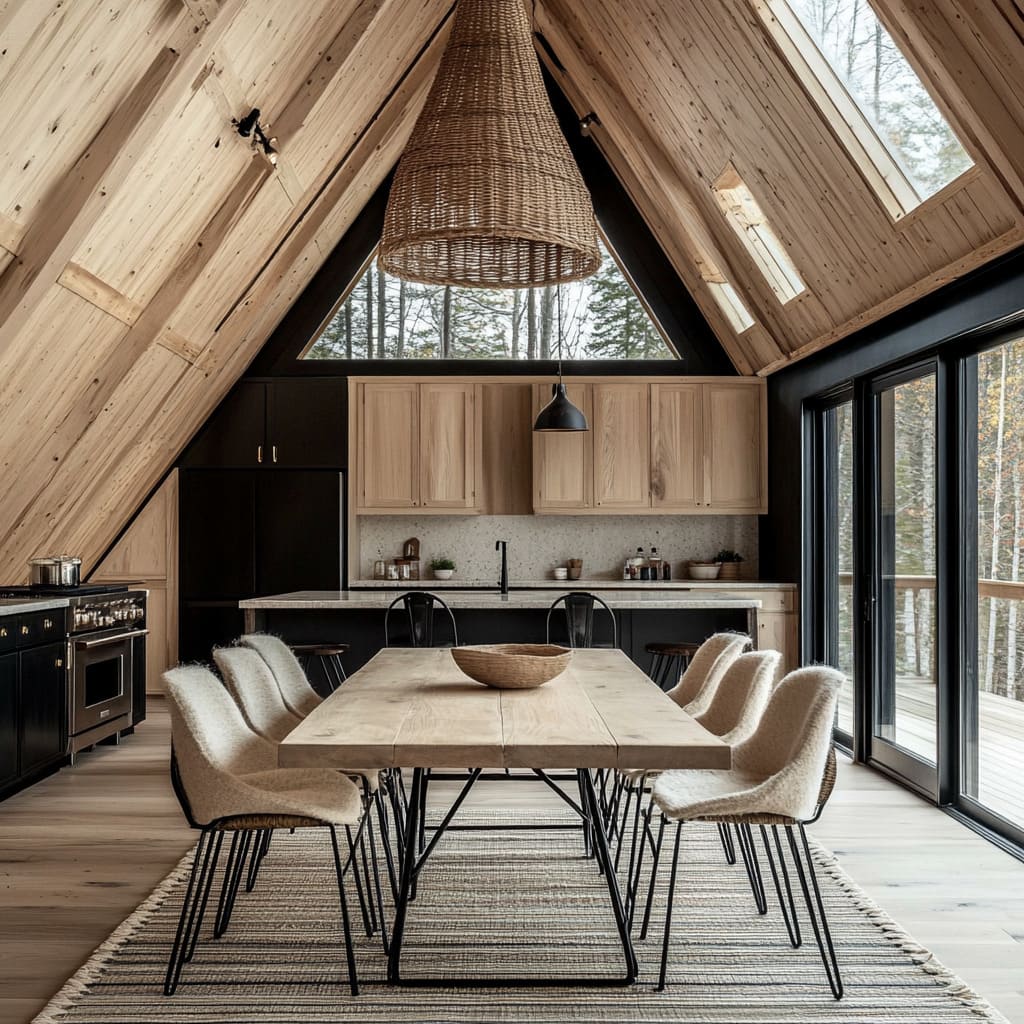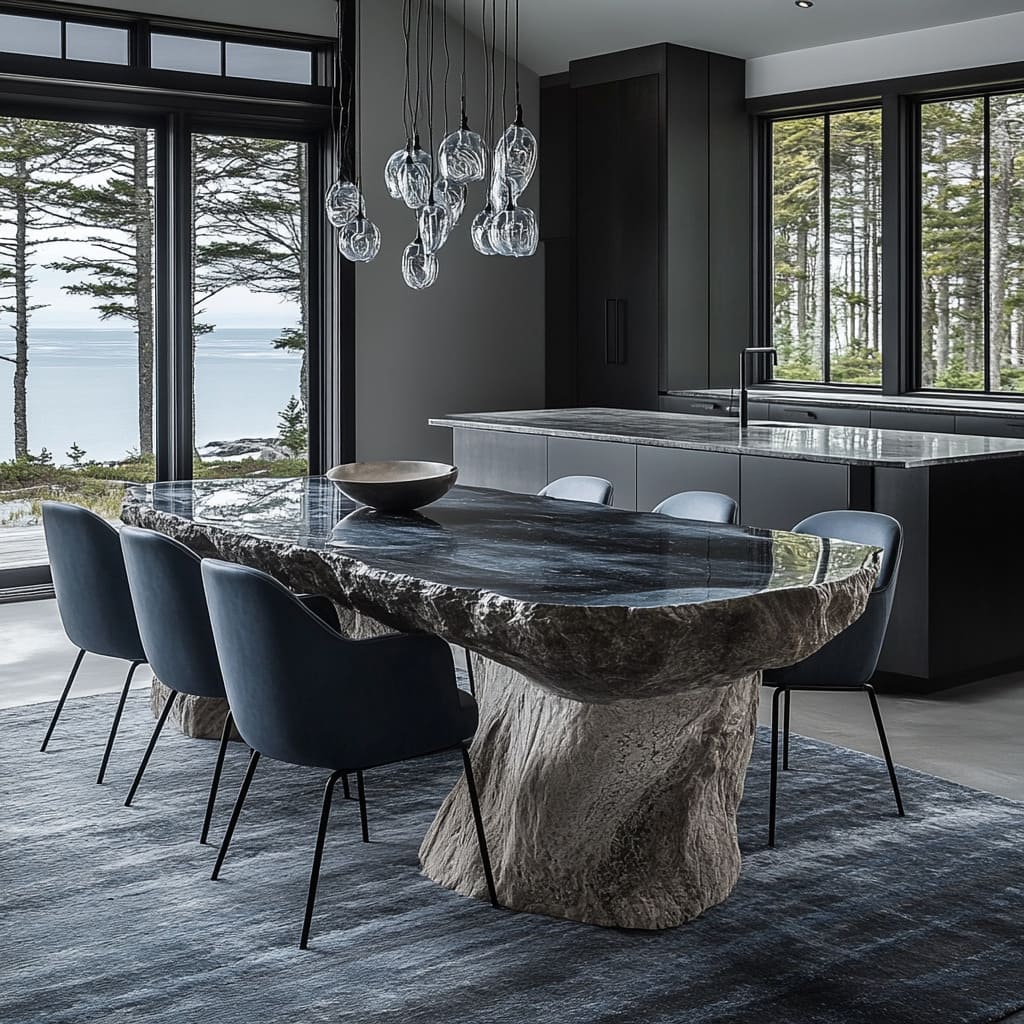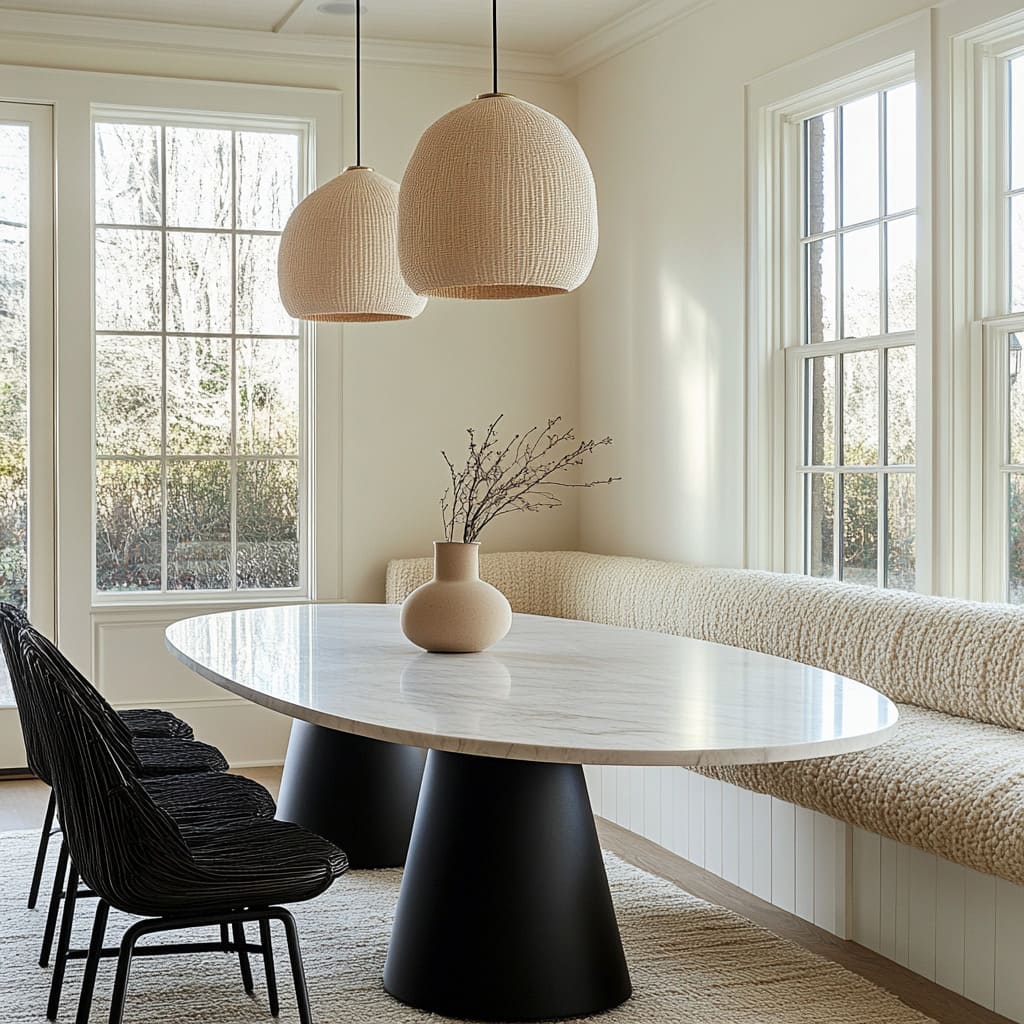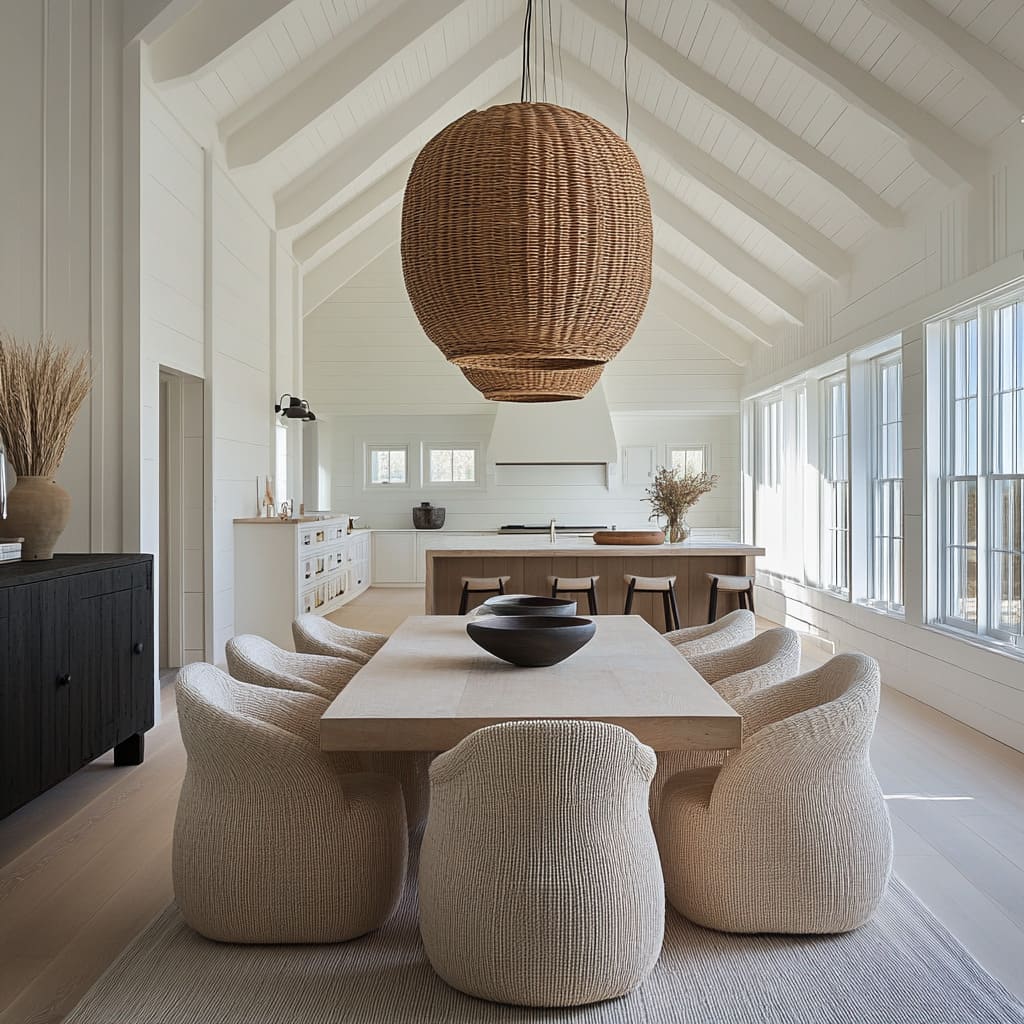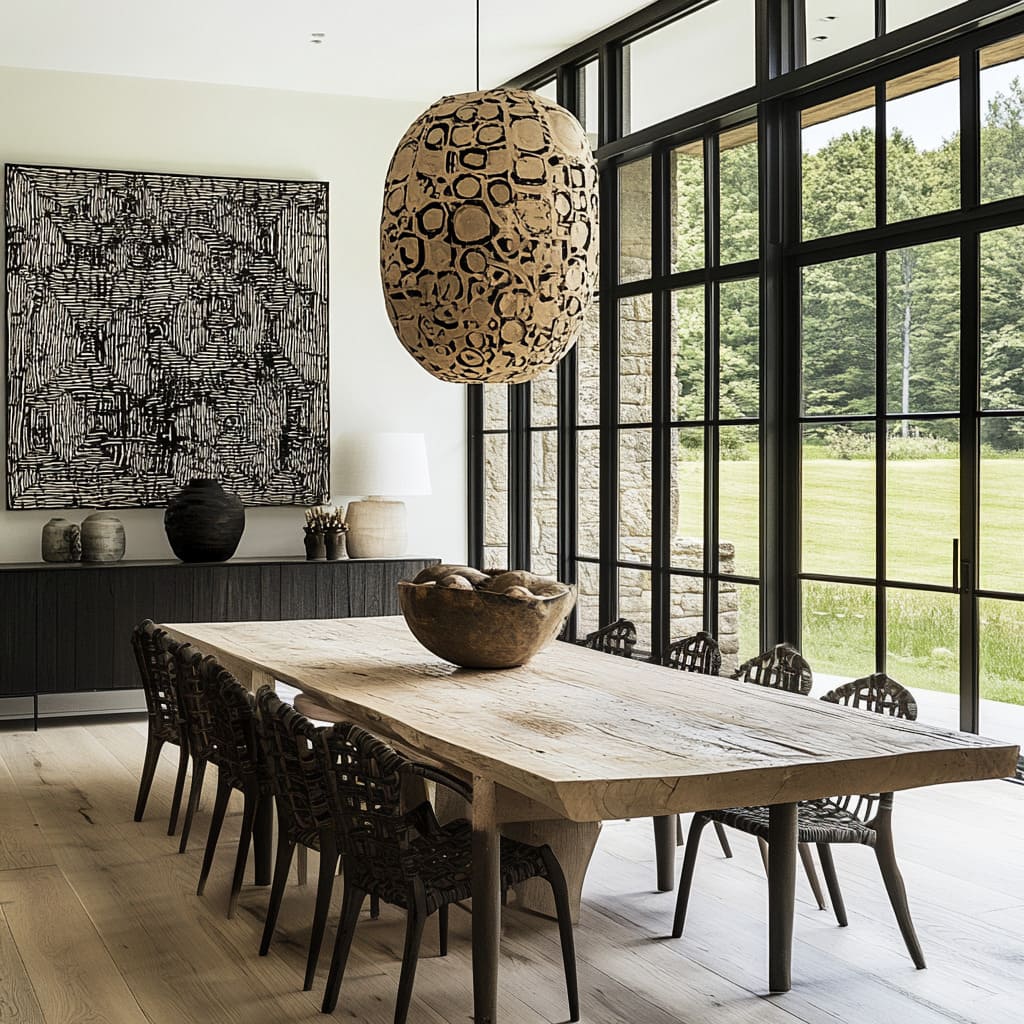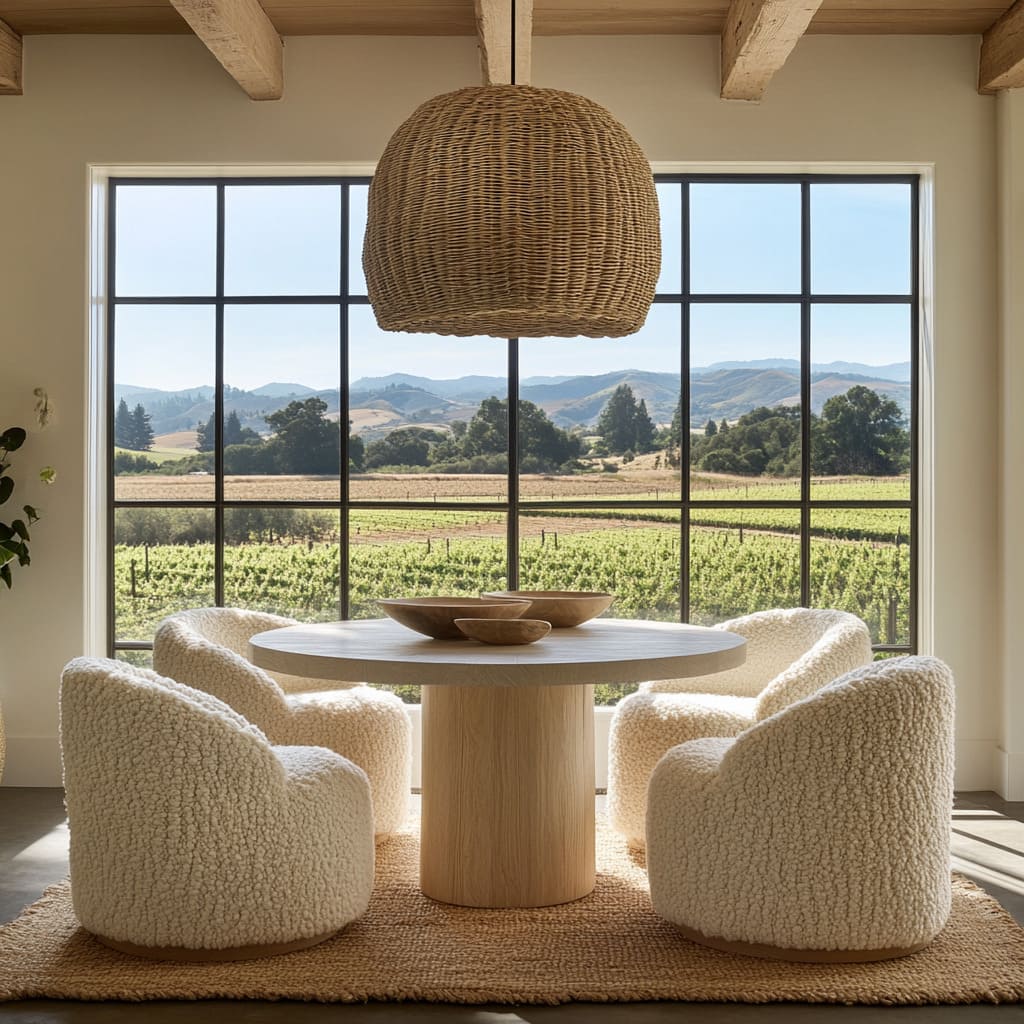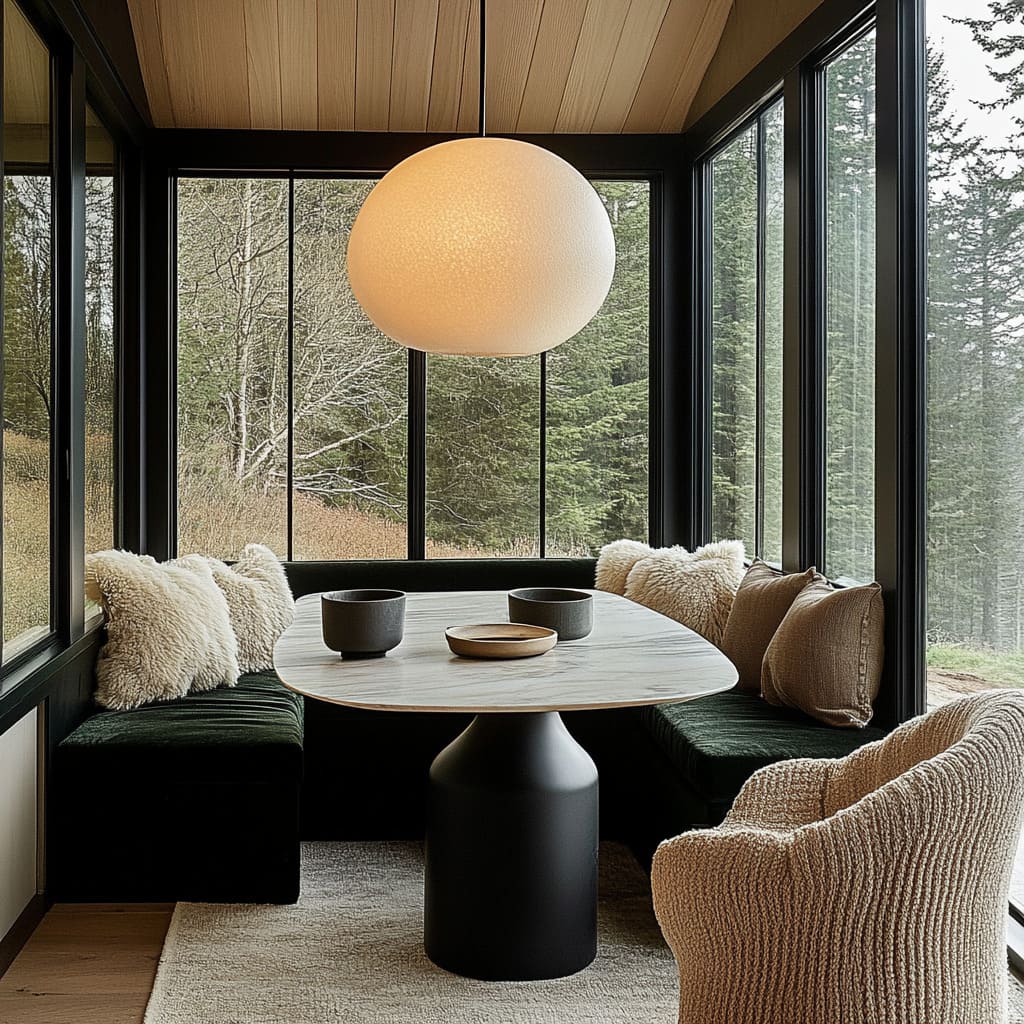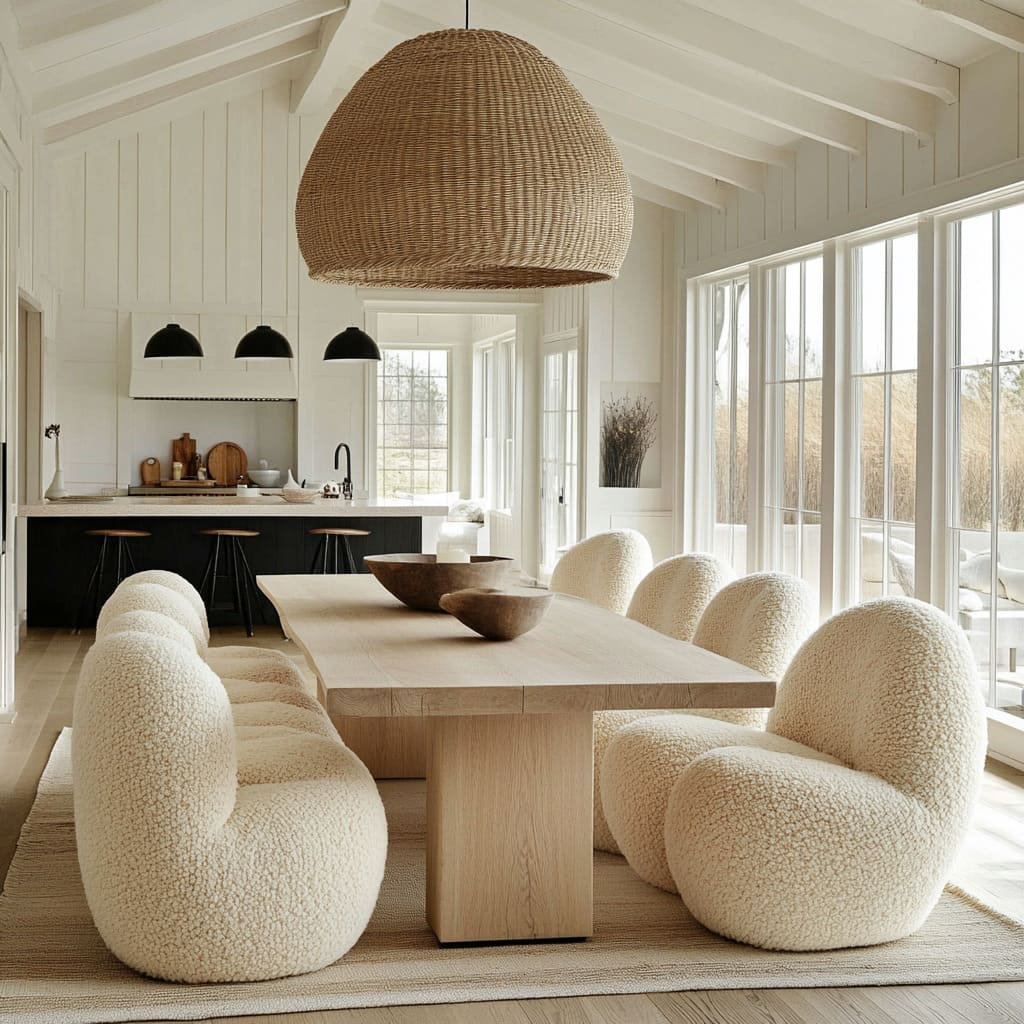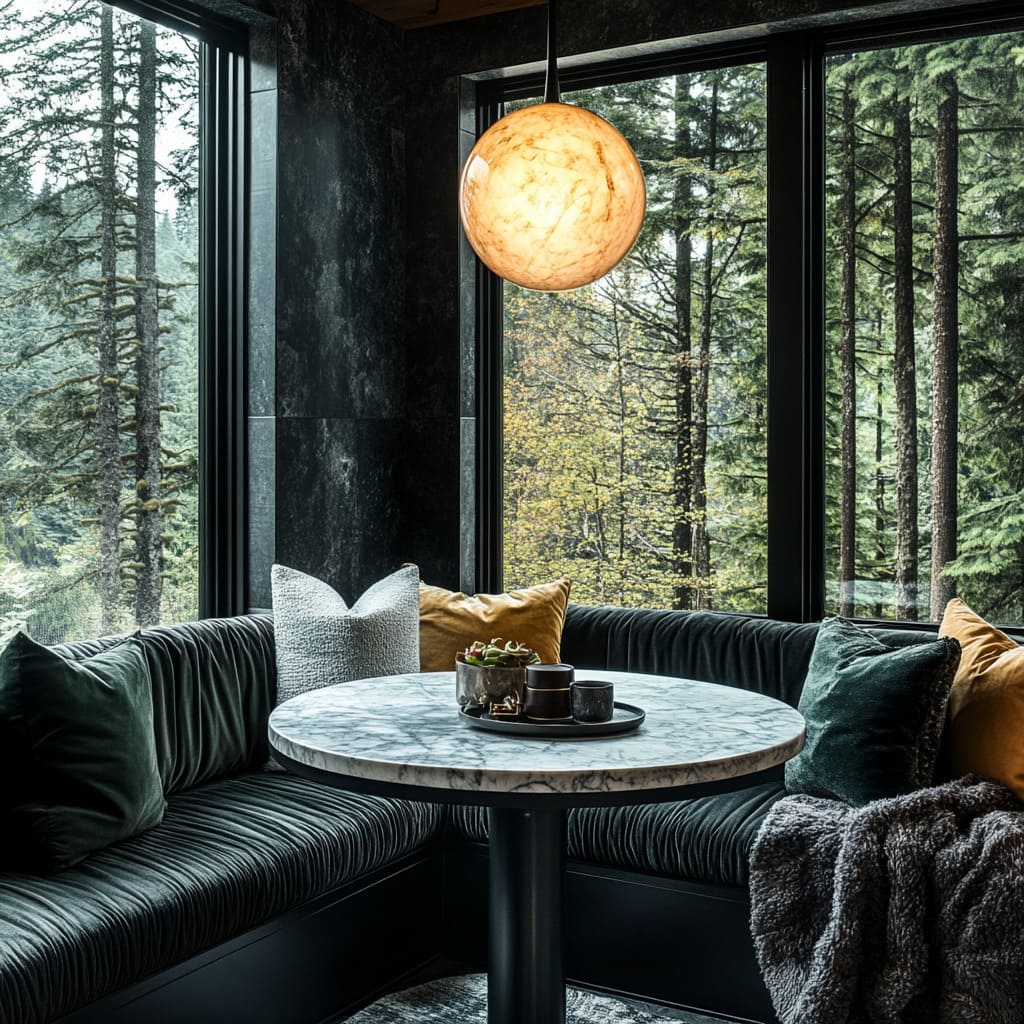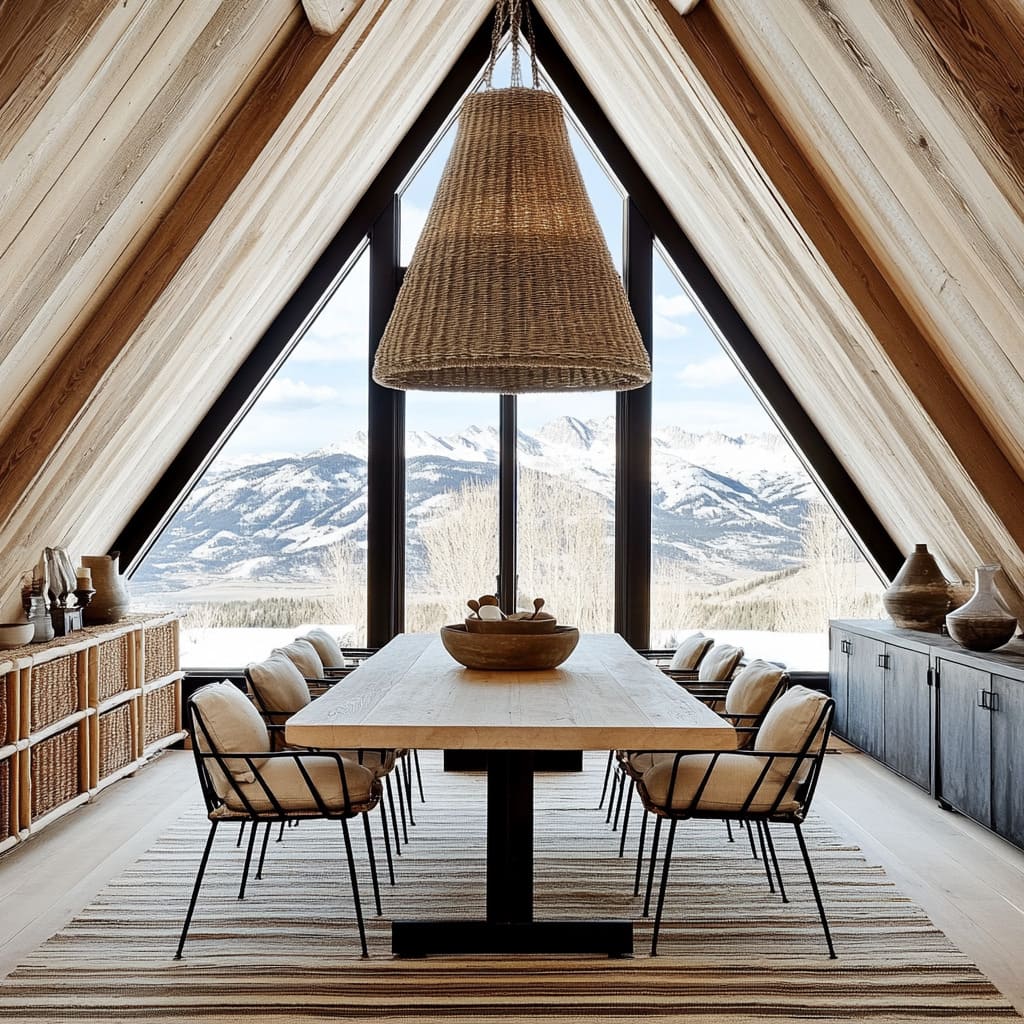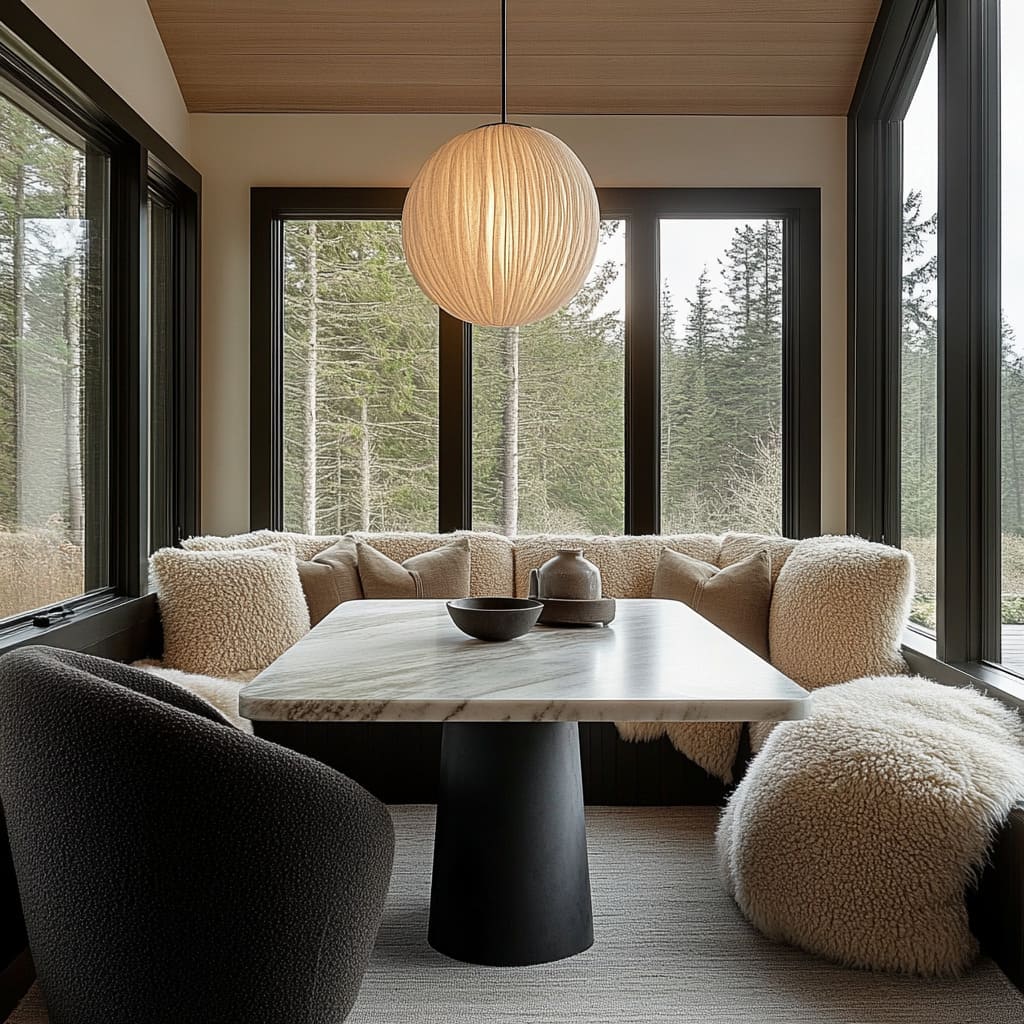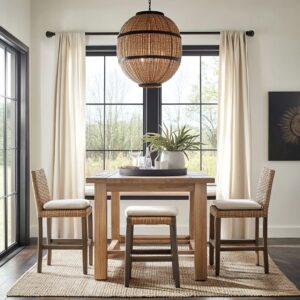The dining room is evolving into much more than a place for meals; it’s becoming a space where style meets comfort and where indoor luxury meets the organic feel of the outdoors. Today’s trend of blending natural beauty with refined design is resonating with homeowners and designers alike.
This approach creates dining areas that are not only visually striking but also bring a sense of tranquility and warmth, mirroring nature’s aesthetics within the comfort of our homes. Whether you’re drawn to the coziness of a well-designed breakfast nook or the spacious grandeur of an A-frame dining room, each of these spaces has the potential to make a lasting impression.
In this article, we’ll explore a variety of luxurious dining room designs that embrace the raw elegance of nature. From dining nooks that offer a snug, intimate setting to open spaces with large windows that invite in natural light and scenic views, these designs showcase the perfect mix of luxury and natural charm.
We’ll take a look at how natural materials, thoughtful color palettes, and carefully chosen furnishings bring sophistication and comfort to the dining room. Whether you’re looking for modern dining room ideas or simply seeking inspiration to bring a touch of the outdoors inside, these spaces show how dining rooms can become highlights of any home.
The Beauty of Natural Elements in Dining Rooms
Natural elements have a unique way of adding character, warmth, and calm to a space. This is especially impactful in dining rooms, where comfort and ambiance are key.
Incorporating elements like wood, stone, and plants into the dining area creates a grounding effect, making the space feel both inviting and luxurious. The growing appeal of nature-inspired dining rooms lies in their ability to offer a refuge from the synthetic, a space where raw textures and earthy tones reconnect us to the outdoors, even within urban settings.
Material Focus
Using natural materials brings depth and authenticity to dining spaces. Live-edge wood tables, with their unique grain patterns and irregular edges, are a prime example of how natural materials make a statement while keeping the space connected to nature.
These tables are more than functional surfaces—they’re conversation pieces, each telling a story of its origin. Paired with designer dining room chairs that balance comfort and style, the look becomes both sophisticated and grounded.
Beyond wood, velvet upholstery on seating can introduce a rich texture, offering a plush feel that contrasts beautifully with the rawness of wood. Rattan and wicker also make appearances in nature-inspired dining rooms, lending a lighter, airy quality.
Marble adds a polished touch that blends luxury with organic beauty, especially when paired with subtle colors that mimic stone and earth. Blown glass lighting fixtures are another popular choice, mimicking the fluid, unpredictable shapes found in nature.
Their translucent quality adds visual interest without overwhelming the space, allowing the room’s natural elements to take center stage.
Visual Connection
One of the most striking features in nature-inspired dining rooms is the use of large windows that frame views of the outdoors. Instead of being isolated, the dining area becomes part of a larger visual landscape, merging with views of forests, mountains, gardens, or even cityscapes.
This connection to the outdoors amplifies the natural aesthetic, bringing in light and views that shift with the seasons. In coastal-inspired homes, for example, windows might frame sweeping beach scenes, creating a dining experience that feels both luxurious and connected to nature.
These expansive windows not only fill the space with natural light but also provide an ever-changing backdrop. The beauty of a dining room designed with nature in mind is that it feels dynamic, with the scenery outside adding seasonal charm and variety to the space inside.
This approach makes dining rooms more than just a place to eat; they become immersive environments that draw on the beauty of the world beyond.
Creating Coziness with Dining Nooks
While large dining rooms are often the focal point in spacious homes, smaller, cozy dining nooks offer an equally luxurious and inviting option, perfect for those who love a more intimate setting. These nooks are versatile spaces, often tucked into corners or next to windows, offering a casual and warm alternative for meals, morning coffee, or evening tea.
Embracing Small Spaces
The charm of a dining nook lies in its intimate scale. It’s a space that doesn’t demand a grand layout but still feels complete.
Unlike larger dining areas, these nooks have a snug, private quality, making them ideal for smaller homes or as a complementary dining option in larger homes. With the right design, a nook can exude as much style and comfort as a full-sized dining room.
A well-thought-out dining nook feels intentional and cozy, with each element playing a role in creating an inviting spot for meals or quiet moments.
Material and Color Choices
To make these dining nooks feel as luxurious as they are cozy, designers often turn to rich, tactile materials and earthy color palettes. Velvet upholstery, for instance, brings a soft, luxurious touch to the space, enhancing the sense of comfort.
Shades like deep green, taupe, and warm ochre introduce an organic feel that ties the nook to nature. Leather is another popular choice, especially when combined with textured materials like stone and wood, creating a balanced and grounded look.
These hues and textures don’t just look good—they make the space feel lived-in, encouraging you to settle in and enjoy the surroundings.
Case Examples
Imagine a dining nook wrapped in deep green velvet banquette seating, set against a backdrop of floor-to-ceiling windows that reveal a view of leafy trees or a serene courtyard. The dark tones of the upholstery create a cozy, enclosed feel, while the natural view expands the space visually.
Or consider a nook with warm beige leather seating, complemented by a solid stone or wood table, giving the area a blend of rustic charm and modern comfort. These choices allow the space to feel curated yet approachable, making it a true retreat within the home.
Lighting Focus
Lighting is essential in dining nooks, both for functionality and to enhance the ambiance. A single pendant light centered above the nook creates a warm and focused glow, adding to the sense of coziness without overwhelming the space.
Choosing a light fixture with natural materials, like rattan or woven fiber, can introduce texture while maintaining harmony with the natural theme. The warm glow of the pendant light highlights the nook’s textures and colors, creating a comfortable, welcoming atmosphere perfect for intimate gatherings.
In larger dining rooms, lighting often needs to fill a bigger space, but in a nook, the lighting is focused, making each meal feel like a cozy occasion. The addition of soft cushions or throws in coordinating colors adds another layer of warmth, reinforcing the idea that this is a space meant for relaxation and enjoyment.
With just a few thoughtfully chosen elements, these dining nooks become the perfect blend of style, comfort, and natural beauty.
The Drama of A-Frame Dining Rooms
A-frame dining rooms bring a sense of awe, thanks to their distinctive triangular architecture and towering ceilings. This style, known for its striking shape, often features steeply sloped walls that create a dramatic focal point in any dining space.
With high ceilings and expansive, angular windows, A-frame structures offer an open, airy feel that connects the dining area to the outdoors in a way that feels both grand and inviting. This design choice is ideal for those looking to make a bold statement while still embracing a warm, natural atmosphere.
A-Frame Architecture
The unique charm of A-frame architecture lies in its bold structure. Unlike traditional dining rooms, the A-frame’s sharp angles and open spaces give a sense of height and expansiveness, making the room feel like part of the landscape rather than an enclosed space.
The triangular windows that often accompany A-frame designs allow natural light to pour in, illuminating the textures of wood and stone that define the room’s interior. This architectural style is especially popular in areas surrounded by scenic beauty, where floor-to-ceiling glass enhances the view and brings a stunning outdoor backdrop directly into the dining experience.
Using Statement Lighting
Oversized pendant lights play a crucial role in these spaces, adding a layer of warmth and character that balances the room’s openness. Statement lighting fixtures, especially those crafted from woven materials, contribute a natural, textural element that harmonizes with the A-frame’s organic appeal.
Large, basket-style pendants can add a cozy glow and create a central visual element that draws the eye upwards, emphasizing the room’s height. These fixtures serve as artistic pieces that bring depth and richness to the overall aesthetic.
Furniture and Layout
In an A-frame dining room, the furniture must complement the structure without overshadowing it. This is where minimalist pieces truly shine.
Large wood tables, often with a raw, natural finish, ground the space and offer a sense of simplicity that matches the architecture’s bold lines. Paired with rattan-backed chairs or other minimalist seating options, the layout achieves a look that’s both refined and relaxed.
By focusing on clean lines and natural materials, the furniture in an A-frame dining room enhances the space’s architectural beauty rather than competing with it.
Bringing in the Outdoors
One of the standout features of A-frame dining rooms is the sense of openness and connection to the natural world. Floor-to-ceiling windows are essential in bringing in natural light and framing the views outside, which might include sweeping mountain landscapes or serene water vistas.
This setup makes dining feel like an immersive experience, with the outdoors becoming a natural extension of the room. The changing scenery throughout the day adds dynamic energy to the dining space, making each meal feel fresh and invigorating.
Live-Edge Tables as Statement Pieces
Live-edge tables have become a popular choice for those looking to bring a piece of nature into their dining rooms. These tables showcase the raw, untouched edges of the wood, allowing the natural curves and textures of the tree to shine through.
Each live-edge table is one-of-a-kind, a distinctive piece that draws attention with its unique character and rugged elegance.
Why Choose Live-Edge Tables?
The appeal of live-edge tables lies in their individuality. No two tables are exactly alike, as each piece of wood has its own unique grain, shape, and color variations.
This brings a handcrafted, natural touch to the dining room, setting it apart from more conventional choices. Live-edge tables act as natural artwork within the room, showcasing the beauty of the wood in its raw form.
Style and Versatility
One of the standout features of live-edge tables is their versatility. They work beautifully in both rustic and modern settings, adapting to various design themes with ease.
In a modern dining room, a live-edge table introduces warmth and texture, balancing sleek lines and minimalist decor with a natural focal point. This organic feel complements other natural elements, like stone or metal, and the table’s simple, unpolished beauty can elevate the room, making it feel cozy yet refined.
Pairing with Seating
The type of seating you pair with a live-edge table can dramatically impact the room’s style. For a soft, luxurious look, plush velvet chairs add a touch of richness that contrasts with the ruggedness of the wood.
Rattan chairs bring a light, airy feel that emphasizes the natural vibe, ideal for a more relaxed style. Modern, metal-framed chairs add a contemporary edge, highlighting the table as a central piece while giving the dining area a clean, stylish look.
Choosing the right seating allows you to personalize the table’s impact, tailoring it to suit the room’s overall aesthetic.
Maintenance Tips
While live-edge tables are stunning, they require some attention to maintain their appearance. Regular dusting and occasional oiling help to preserve the wood’s natural color and texture.
Avoid placing the table in direct sunlight, as this can cause the wood to fade over time. With a bit of care, a live-edge table can retain its unique beauty and continue to be a statement piece in your dining room for years to come.
Choosing the Perfect Lighting
Lighting is a vital element in any dining room, especially in spaces where natural materials and textures play a starring role. The right lighting can enhance these features, adding warmth, depth, and atmosphere to the room.
From oversized pendants to delicate glass fixtures, lighting choices are as varied as the designs they illuminate, each adding its own layer of style and functionality.
Statement Pendant Lights
Oversized pendant lights are often the go-to choice for creating a focal point in the dining room. When crafted from natural materials like woven rattan or artisanal blown glass, these pendants add a unique, textural quality that complements nature-inspired designs.
They draw the eye upward, balancing the room’s dimensions and creating a sense of height without overwhelming the space. This approach is especially effective in dining rooms with high ceilings or A-frame structures, where a bold fixture can hold its own amidst the grandeur of the space.
Creating Ambiance
Lighting sets the tone for any dining room, and different choices can dramatically impact the mood. Warm-toned bulbs create a cozy, inviting atmosphere, perfect for intimate dinners or gatherings.
Meanwhile, strategically placed fixtures can highlight textures, like the grain of a live-edge table or the woven pattern of rattan chairs. Layered lighting, such as a mix of overhead and accent lights, provides flexibility, allowing you to adapt the ambiance to different occasions.
Types of Lighting for Different Dining Rooms
Different dining room styles call for different lighting solutions. For cozy breakfast nooks, a single globe light or pendant works well, providing focused illumination without cluttering the space.
In larger dining rooms, layered lighting is ideal, offering a blend of ambient and task lighting to cover all needs. Unique glass pendants, especially those with organic shapes, are perfect for contemporary spaces, mimicking natural forms and adding an artistic touch.
By choosing lighting that suits the room’s scale and style, you can enhance both the functionality and aesthetic of your dining space. In essence, lighting is more than a practical necessity—it’s a design element that brings out the best in each piece of furniture, texture, and color within the dining room.
With thoughtful choices, lighting transforms a dining room into a comfortable, visually captivating space where every detail shines.
Color Palettes Inspired by Nature
Bringing the colors of nature into a dining room can create an atmosphere that feels both luxurious and grounded. Using earthy and organic tones can help craft a space that feels like a seamless blend of elegance and natural beauty, inviting guests to feel at ease and connected to their surroundings.
Earthy and Organic Colors
One of the key elements in nature-inspired design is the use of a color palette drawn directly from the natural world. Earthy greens, deep blues, sandy beiges, and rich wood tones are perfect choices for evoking a calming ambiance in the dining room.
Green tones, ranging from soft moss to vibrant olive, bring a hint of the forest indoors, fostering a feeling of tranquility and balance. Deep blues channel the serenity of a nearby lake or the open sky, adding depth without overwhelming the room.
Accents and Contrasts
Accents can add character and visual interest without detracting from the natural, understated elegance of an earthy palette. Colors like ochre, moss green, and charcoal introduce a layer of sophistication and complexity.
Ochre, with its warm, golden undertones, brings a sunny, inviting quality that can highlight specific features like an accent wall or decorative pottery. Charcoal adds depth, giving the room a modern touch that balances rustic elements with a contemporary edge.
Examples of Color Schemes
For those looking to emulate specific natural settings, there are several color schemes that can help evoke different environments. For a coastal-inspired dining room, consider a combination of sandy beige, soft blue, and seafoam green.
These colors reflect the calmness of the beach, offering a relaxed yet polished vibe. A forest-inspired palette could mix rich greens, deep browns, and subtle grays, reminiscent of a woodland retreat that brings a soothing, grounded feeling to the space.
Each of these palettes can be customized to suit personal tastes while staying rooted in natural inspiration.
Connecting Indoors with Outdoors through Window Design
A well-designed dining room doesn’t just rely on its interior features; it also embraces the outdoors, drawing in natural beauty to enhance the ambiance of the space. Windows play a vital role in this, especially in dining areas where views and light can transform the atmosphere.
Maximizing Natural Views
Large windows are essential in dining rooms that aim to merge indoor elegance with outdoor charm. They allow the room to be bathed in natural light, creating a welcoming environment that feels open and connected to the outside world.
A dining room with expansive windows overlooking a garden, mountain landscape, or even cityscape can bring a fresh, dynamic energy to meals. Not only do these windows brighten the room, but they also provide an ever-changing backdrop, making each dining experience unique.
Framing the Landscape
The placement and size of windows can dramatically influence the way a dining room feels. Floor-to-ceiling windows, especially when paired with a carefully positioned dining table, can frame the surrounding landscape as if it were a piece of art.
Imagine enjoying a meal with a panoramic view of rolling hills or dense forests—this kind of setup allows diners to feel as though they are part of the landscape itself. For dining areas overlooking water, windows that frame the view create a soothing, tranquil effect.
This thoughtful integration of windows and seating is key to achieving a harmonious balance between indoors and outdoors.
Types of Window Treatments
Choosing the right window treatments for a nature-inspired dining room can enhance the room’s ambiance while preserving privacy and light. Minimalist treatments, such as sheer curtains or simple shades, work well in rooms where large windows are the focal point.
Sheer curtains allow light to filter in softly, creating a warm, diffused glow without obstructing views. In spaces that call for a modern touch, custom roller blinds in neutral tones offer a clean, uncluttered look that complements natural materials and colors.
Blending Rustic and Modern Styles
One of the most compelling design approaches in luxury dining rooms is the fusion of rustic and modern elements. This combination brings together the warmth and authenticity of rustic materials with the sleek sophistication of modern finishes, creating spaces that feel both timeless and fresh.
Balancing Elements
To achieve a harmonious blend of rustic and modern, it’s essential to balance rough, textured materials with smooth, refined finishes. Rough stone walls or reclaimed wood tables introduce a sense of history and craftsmanship, grounding the room with an earthy quality.
Pair these with sleek touches like metal accents or velvet upholstery, which add polish and contrast. This combination of materials prevents the space from leaning too far in either direction, resulting in a balanced, cohesive look.
Furniture and Decor Choices
The furniture in a blended rustic-modern dining room should reflect both styles, creating a space that feels cohesive yet layered. A large, rustic wood table serves as a striking centerpiece, embodying the strength and beauty of natural materials.
To add a modern edge, pair it with designer dining room chairs in sleek silhouettes, perhaps in dark metal or velvet finishes. A woven rug in earthy tones can add warmth underfoot, grounding the space and tying together the rustic and modern elements in a way that feels intentional and inviting.
Examples of Fusion Styles
There are countless ways to interpret a rustic-modern fusion, each creating a unique atmosphere in the dining room. One approach could be to combine a reclaimed wood table with metal-framed chairs and a minimalist pendant light, which would suit an industrial-inspired space with a modern edge.
Another option might include plush seating upholstered in velvet, paired with a rustic stone wall and large windows that frame natural views, crafting a dining room that feels refined yet grounded. From earthy color schemes to the integration of rustic and modern styles, these designs invite homeowners to create dining spaces that are not only elegant but also deeply connected to the natural world.
By blending colors, materials, and styles inspired by nature, these dining rooms become more than just a place to eat—they become a sanctuary where the beauty of the outdoors enhances every dining experience.
Artisanal Touches and Decor
Incorporating artisanal decor into a dining room brings a sense of authenticity and craftsmanship that elevates the overall design. These handcrafted elements make a space feel more personal and rooted in tradition, while also adding an extra layer of texture and character.
By choosing pieces that reflect natural beauty and skilled artistry, a dining room can feel curated yet organic, inviting warmth and individuality.
Handcrafted Elements
Handcrafted decor items, such as pottery, woven baskets, and textured ceramics, add unique touches that mass-produced items simply can’t replicate. Each piece, often with subtle imperfections, tells a story of human craftsmanship, introducing character and warmth into the space.
Pottery can bring an earthy, grounded quality to a dining room, especially when displayed as centerpieces or on nearby shelves. Woven baskets, whether used for storage or as wall decor, create a rustic charm that works beautifully in various dining room styles.
Choosing Statement Decor
When decorating a luxury dining room, statement pieces can play a crucial role in defining the room’s aesthetic without cluttering it. A large ceramic bowl with an organic shape can act as a focal point on a dining table, blending function and beauty.
Similarly, woven wall art or tapestries in natural fibers add visual interest without detracting from other architectural elements or textures. Choosing one or two bold decor items allows the room to feel balanced, as each piece has space to shine.
Minimalist Approach to Styling
A minimalist approach to styling is ideal for a nature-inspired dining room, where the focus is on natural materials and textures rather than excessive decor. By keeping decor simple and intentional, you allow the beauty of materials like wood, stone, and glass to stand out.
Consider keeping table decor minimal—perhaps a single ceramic vase with dried branches or a shallow bowl with seasonal fruits. Minimalist decor allows for a tranquil, cohesive space that emphasizes natural beauty, making the dining room feel both luxurious and approachable.
Tips for Achieving a Luxury Dining Room with Natural Beauty
Creating a luxury dining room that incorporates elements of nature requires a thoughtful balance between design and functionality. With the right materials, colors, and layout, you can craft a dining space that feels both opulent and grounded, providing a beautiful backdrop for gatherings and daily meals.
Design Principles
To achieve a luxurious yet nature-inspired dining room, it’s important to start with foundational design principles. Choose high-quality materials like stone, wood, and metal to anchor the space and provide durability.
For a balanced look, combine these materials with soft, earthy color palettes that create a soothing ambiance. Think shades of moss green, warm browns, and deep blues that evoke the outdoors.
Practical Tips
Start with a statement table—live-edge wood tables or tables with unique bases are ideal for creating a connection with natural beauty. Incorporate natural lighting whenever possible, using large windows or skylights to brighten the room and highlight natural materials.
For artificial lighting, oversized pendant lights crafted from rattan or metal can create a soft, inviting glow. Keep the overall aesthetic balanced; mix textures carefully, pairing smooth stone surfaces with plush seating or woven textiles.
Final Touches
The finishing touches can transform a dining room from beautiful to breathtaking. Adding a few plants, whether potted or in hanging planters, introduces a fresh, natural element that complements any decor.
Minimalistic artwork, especially pieces with natural textures or muted colors, can enhance the ambiance without overwhelming the space. Choose textures carefully; woven rugs, linen curtains, or velvet cushions add a touch of luxury while keeping the room grounded in nature.
Conclusion
Combining luxury with nature in dining room design creates spaces that are not only visually stunning but also timeless and comforting. From choosing earthy color palettes to integrating handcrafted decor, every choice contributes to an atmosphere that feels both sophisticated and welcoming.
With these elements, a dining room becomes more than a place to eat—it’s a setting for memories, gatherings, and a true expression of style.
